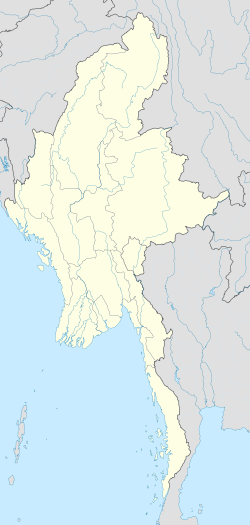
From Wikipedia, the free encyclopedia
For the Singaporean film, see Mogok (film).
| Mogok မိုးကုတ် Mogoke[1] | |
|---|---|
| Coordinates: 22°55′N 96°30′E / 22.917°N 96.5°ECoordinates: 22°55′N 96°30′E / 22.917°N 96.5°E | |
| Country | |
| Region | Mandalay Region |
| District | Pyin Oo Lwin |
| Township | Mogok |
| Government | |
| - Mayor | |
| Population (2005) | |
| - Total | 150,000 |
| - Religions | Theravada Buddhism |
| Time zone | MST (UTC+6.30) |
Mogok (Burmese: မိုးကုတ်, pronounced [móɡouʔ]; Shan: မိူင်းၵုတ်ႈ) is a city in the Pyin Oo Lwin District of the Mandalay Region of Burma (Myanmar), located 200 km north of Mandalay and 148 km northeast of Shwebo.
Geography
At 1170 meters in elevation, the city has fairly temperate climate year-round, and is home to mostly Bamar, with large minorities of Shan, Lisu, Palaung, Karen ethnic groups, as well as Chinese, Indians and Gurkha.
Repute for gemstones
Mogok and other villages nearby have been famous since ancient times for its gemstones, especially ruby and sapphire, but semi-precious stones such as lapis lazuli, garnet, moonstone, peridot and chrysoberyl are also found. The gems are found in alluvial marble gravels by means of panning, tunneling and digging pits by hand. There is little mechanization of the mining. The gravels derive from the metamorphosed limestones (marbles) of the Mogok metamorphic belt.[2][3]
Gems are sold in markets in Mogok; however, foreigners require special permits to visit the town, and purchase/export of gems from Myanmar at non-government licensed dealers is illegal.
90% of the world's rubies come from Myanmar. The red stones from there are prized for their purity and hue. Thailand buys the majority of Myanmar's gems. The "Valley of Rubies", the mountainous Mogok area, 200 km (125 miles) north of Mandalay, is noted for its rare pigeon's blood rubies and blue sapphires. Working conditions in the mines, however, are said to be horrendous. Debbie Stothard of the Alternative ASEAN Network on Burma stated that mining operators used drugs on employees to improve productivity, with needles shared, raising the risk of HIV infection: "These rubies are red with the blood of young people." Brian Leber (jeweler who founded The Jewellers' Burma Relief Project) stated that "for the time being," Burmese gems should not be something to be proud of.[4]
[edit] Notes
- ^ "Pyin Oo Lwin / Mogoke Map" Myanmar Information Management Unit (MIMU)
- ^ Searle, D. L.; Ba Than Haq (1964) "The Mogok belt of Burma and its relationship to the Himalayan orogeny" Proceedings of the 22nd International Geological Conference, Delhi 11: pp. 132–161
- ^ Iyer, Lakshinarayanpuran Anantkrishna Narayana (1953) The geology and gem-stones of the Mogok Stone Tract, Burma Geological Survey of India Memoir 82, Government of India Press, Calcutta, OCLC 6526679 ; reprinted in 2007 by White Lotus, Bangkok, ISBN 978-974-480-123-4
- ^ Crimmins, Carmel (7 October 2007) "Move over, blood diamonds" Reuters, from Internet Archive of 16 February 2008
The Mogok blue sapphire are not found from the primary origin,the Mogok blue sapphire are explored from secondary deposit mines,one of the best quality blue sapphires mines was loadket mine at kyukpyatthart village ,western part of Mogok.Nowadays ,one of the most famous sapphires mine,it is saturated in the Bawmar village ,western Mogok.The other colurs of corundum are call colour sapphire,it may confused to the pale red or pink ruby are widely called as pink sapphire in the international market. The Mogok ruby production are going dawn in this decade ,some major mines are 300meters depth and over and below 100meter of ground water table@level so water must pump out to get the marbles with ruby.All of the mines must be pump out at the same time for at least 30days .




No comments:
Post a Comment